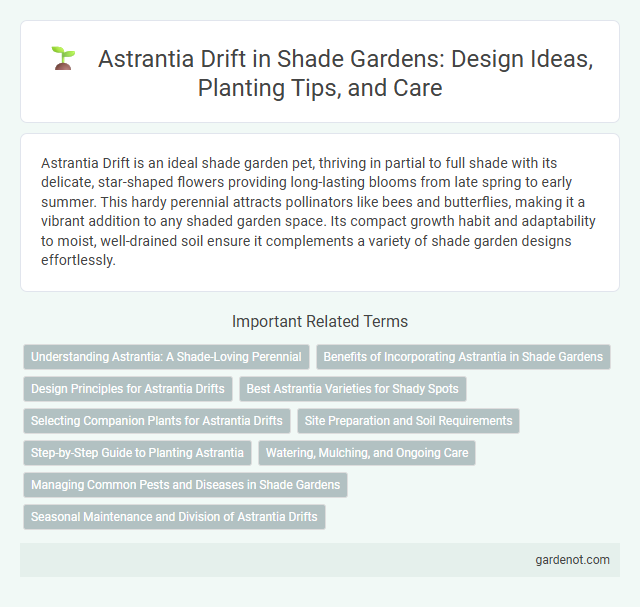Astrantia Drift is an ideal shade garden pet, thriving in partial to full shade with its delicate, star-shaped flowers providing long-lasting blooms from late spring to early summer. This hardy perennial attracts pollinators like bees and butterflies, making it a vibrant addition to any shaded garden space. Its compact growth habit and adaptability to moist, well-drained soil ensure it complements a variety of shade garden designs effortlessly.
Understanding Astrantia: A Shade-Loving Perennial
Astrantia Drift thrives in shaded gardens, making it an ideal perennial for low-light environments. Its distinctive star-shaped flowers attract pollinators like bees and butterflies, enhancing garden biodiversity. With minimal maintenance and strong resistance to pests, Astrantia Drift ensures lasting beauty and vitality in shaded landscapes.
Benefits of Incorporating Astrantia in Shade Gardens
Astrantia drift thrives in shade gardens, offering vibrant, long-lasting blooms that attract pollinators like bees and butterflies, enhancing biodiversity. Its drought tolerance and low maintenance requirements make it ideal for shaded areas with limited sunlight. Incorporating Astrantia drift improves soil health by promoting organic matter and prevents erosion with its dense root system.
Design Principles for Astrantia Drifts
Astrantia drift design principles emphasize grouping plants in clusters to create a naturalized, woodland effect that maximizes visual impact and seasonal interest. Selecting varying heights and bloom times within Astrantia cultivars ensures continuous texture and color throughout the growing season. Incorporating complementary shade-tolerant perennials enhances biodiversity and maintains soil moisture, promoting healthy and sustainable garden ecosystems.
Best Astrantia Varieties for Shady Spots
Astrantia drift is a top choice for shade gardens, known for its ability to thrive in low-light conditions while offering vibrant blooms. Among the best Astrantia varieties for shady spots are Astrantia major 'Roma', prized for its deep red flowers, and Astrantia major 'Claret', which features rich burgundy hues that brighten dim areas. These varieties provide long-lasting color and attract pollinators, making them ideal for enhancing shaded garden spaces.
Selecting Companion Plants for Astrantia Drifts
Selecting companion plants for Astrantia Drift involves choosing species that thrive in partial shade and moist, well-drained soil, such as ferns, hostas, and astilbes. These plants complement the delicate, star-shaped flowers and lush foliage of Astrantia Drift while enhancing garden texture and color contrast. Incorporating shade-tolerant groundcovers like pulmonaria or lamium can also help suppress weeds and maintain soil moisture.
Site Preparation and Soil Requirements
Astrantia Drift thrives in moist, well-drained soil enriched with organic matter, making soil preparation critical for healthy growth. Site selection should ensure partial to full shade, protecting the plant from intense sunlight while maintaining consistent soil moisture levels. Amending soil with compost or peat moss enhances fertility and drainage, supporting robust root development in shaded garden environments.
Step-by-Step Guide to Planting Astrantia
Choose a shaded location with well-draining, humus-rich soil to plant Astrantia 'Drift'. Dig a hole twice the width of the root ball, gently place the plant in, and backfill with soil, ensuring the crown is level with the ground surface. Water thoroughly and mulch around the base to retain moisture and suppress weeds, promoting healthy growth in shade gardens.
Watering, Mulching, and Ongoing Care
Astrantia Drift thrives in consistently moist soil, requiring regular watering to prevent drought stress, especially during dry spells. Mulching with organic material such as shredded bark or compost helps retain soil moisture, suppress weeds, and regulate temperature around the roots. Ongoing care includes removing spent flowers to encourage prolonged blooming and dividing clumps every few years to maintain plant vigor and health.
Managing Common Pests and Diseases in Shade Gardens
Astrantia Drift thrives in shade gardens but can be vulnerable to pests like aphids and slugs as well as diseases such as powdery mildew. Regularly inspect the plants for early signs of infestation and use natural predators like ladybugs or organic pesticides to control aphids while deploying slug traps or barriers to reduce slug damage. Ensuring proper air circulation and avoiding overhead watering helps prevent fungal diseases, promoting healthier growth and vibrant blooms.
Seasonal Maintenance and Division of Astrantia Drifts
Astrantia Drifts require regular seasonal maintenance to ensure vibrant blooms and healthy growth, including deadheading spent flowers and cutting back foliage in late autumn. Division of Astrantia Drifts is best performed in early spring or late autumn to promote vigorous new shoots and prevent overcrowding. Proper division improves air circulation and nutrient uptake, enhancing the plant's overall resilience and lifespan in shade gardens.
Astrantia drift Infographic

 gardenot.com
gardenot.com